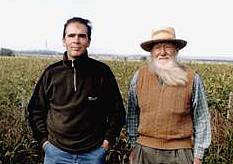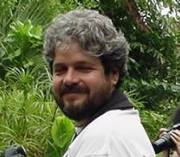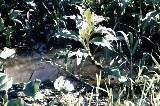|
THE HARDY VICTORIA WATERLILY OF ARGENTINA Part II Translation from Spanish to English by Fernando Santos Click images to enlarge |
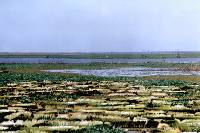 |
|
Thanks to my mentor Walter Pagels.
The present article has its background in a previous one published
in The Water Garden Journal Vol 15 #2 (Summer 1999) titled "The
Search for Irupé -- The Hardy Victoria Waterlily of Argentina"
and on line at www.irupe.com/trip9903/index.html which Lindsay
"Butch" Weaver wrote together with Walter Pagels soon
after their trip to Argentina back in 1999. The purpose of the
trip was to collect seeds from the Irupé (the popular
name given in Argentina and Paraguay to Victoria cruziana)
in its natural habitat.
For me, just a beginner in water gardening together with my wife Helena, all this generated a tremendous feeling and I let my imagination run free. I visualized being part of a documentary series from the National Geographic Society that might make history. Perhaps it was not like that, but within my heart was this joy of being the one who was going to help them make the expedition possible, and this joy is still within me even now that I have achieved more experience and knowledge.
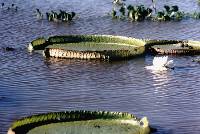 That
trip back in 1999 was a partial success, since everything came
out well with respect to lodging, guide, finding natural communities
of Victoria cruziana, collecting seeds and bringing them
back home to USA, but the main goal was not achieved as the collected
seeds did not prosper, perhaps due to being harvested before
they were fully ripened.
That
trip back in 1999 was a partial success, since everything came
out well with respect to lodging, guide, finding natural communities
of Victoria cruziana, collecting seeds and bringing them
back home to USA, but the main goal was not achieved as the collected
seeds did not prosper, perhaps due to being harvested before
they were fully ripened.
Several years passed but Walter Pagels kept his desire to
achieve the unfinished goal of the first expedition. He contacted
me again, expressing his desire to try once more to 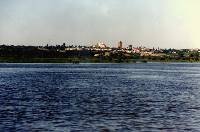 collect Victoria
cruziana seeds, but this time in mid-April, one month later
than he tried back in 1999, just the beginning of fall in the
southern hemisphere. Because of repetition everything was much
easier. All lodging matters in Buenos Aires and at the town of
Victoria, in the Entre Rios province, (the name of the city refers
to a war victory of the Spanish army in the XVIII century against
the aboriginals of the region) were arranged with great ease,
in the same places as Walter had been three years before, but
this time with a substantial difference -- I would be a member
of this adventure! Thanks to him for his kindness and generosity
in inviting me, with my only requirements being to arrange the
car and to be the driver from Buenos Aires to Victoria, which
is a 350 kilometer drive.
collect Victoria
cruziana seeds, but this time in mid-April, one month later
than he tried back in 1999, just the beginning of fall in the
southern hemisphere. Because of repetition everything was much
easier. All lodging matters in Buenos Aires and at the town of
Victoria, in the Entre Rios province, (the name of the city refers
to a war victory of the Spanish army in the XVIII century against
the aboriginals of the region) were arranged with great ease,
in the same places as Walter had been three years before, but
this time with a substantial difference -- I would be a member
of this adventure! Thanks to him for his kindness and generosity
in inviting me, with my only requirements being to arrange the
car and to be the driver from Buenos Aires to Victoria, which
is a 350 kilometer drive.
So, on the long awaited day, Tuesday 16 April of 2002, Walter arrived in Buenos Aires. I went to see him in the early afternoon at the hotel where I had made the reservation for him and there with great pleasure I received unexpected gifts: N. 'Walter Pagels', N. 'Arc-en-Ciel, Neptunia aquatica, Aeschynomene fluitans (Botswana Wonder) and some other plants. Many reading this article will consider these ordinary, but this is not the case in Argentina, where water gardening is in its beginnings and there are only a few aquatic plants.
That same day, a strong rain storm whipped Buenos Aires and the outskirts of the city, and suddenly I imagined that our trip was at risk, but Walter did not pay much attention to that. He was full of optimism, and our conversation in his hotel room centered on our main themes of interest: plants, a book that I gave him as a gift about Common Aquatic Vegetation of the Paraná Delta and the areas surrounding Buenos Aires; also about the work of Dr. John Wiersema on Nymphaea subgenus Hydrocallis (nothing fancy as an ornamental for water gardening, but the only native of my country) and some advise on how to pronounce certain scientific names (the Latin root of the Spanish language allows us to pronounce with greater precision the names in Latin that are assigned as scientific names -- in English you need to guess or just imagine how it is pronounced). As I left, we agree I would pick him up the following morning at 8 a.m.
Wednesday 17, at the exact hour I promised, we left the Hotel
President where Walter stayed and, just as he predicted, the
day was completely clear and it promised to be a trip without
inconvenience and the successive days exceptional. We took the
North Highway which accesses Buenos Aires and after 60 kilometers
we crossed the bridge "Zárate-Brazo Largo",
passing over two large arms of the Río Paraná before
reaching Río de La Plata and the intermediate islands
of "Brazo Paraná de las Palmas" and "Brazo
Paraná Miní". Surely Walter will recall that
due to my mistake he had to bear 5 kilometers of a local road
in such bad shape that we could have confused it with a lunarscape
setting or just bombarded war ground. Having survived that inconvenience, we crossed the bridge mentioned
before and from there we travelled with no problems to the town
of Victoria. As plants lovers, according to our whim, we stopped
a few places to observe the flora that grew beside the roads
or in small slow streams: Thalias, Hydrocleys nymphoides,
Senecio bonariensis, Pistia stratiotes, Cortaderia selloana
(pampas grass), Eichhornia crassipes and azurea, Solidago
chilensis, etc.
Having survived that inconvenience, we crossed the bridge mentioned
before and from there we travelled with no problems to the town
of Victoria. As plants lovers, according to our whim, we stopped
a few places to observe the flora that grew beside the roads
or in small slow streams: Thalias, Hydrocleys nymphoides,
Senecio bonariensis, Pistia stratiotes, Cortaderia selloana
(pampas grass), Eichhornia crassipes and azurea, Solidago
chilensis, etc.
At one point during our drive, Walter asked me to stop when he spotted a huge formation of Hydrocleys nymphoides (water poppy) in full bloom. After we stopped, I was surprised to see him take from his luggage special footwear like the ones used by surfers or cyclists. He put them on, pulled up his trousers above the knees, took his camera and got into the water to take a close up picture. I am neither a biologist nor explorer. My only contact with nature has been always in tourist places, so seeing someone thousands of kilometres from home getting into an unknown area without paying much attention to insects or a possible water snake that could be on the bottom, gave me a quick glimpse at the spirit of this unusual man.
Around noon we arrived at the lodging "El Cerrito", just few kilometres to the north of Victoria, where we were expected by our hosts, Mrs. Alicia Regiardo and her husband Ruben. We arranged our luggage, had lunch and passed the rest of the day talking, having some rest and getting ready for the next day.
On the following day, Thursday 18th, we woke up at 6:30 am, had breakfast and at 8.00 am our guides came to pick us up to take us to the tiny port of Victoria. From there we went out in two outboard motorboats, one of them with a flat bottom and equipped with a special propeller capable of navigating in shallow waters crowded with floating vegetation.
Part I
